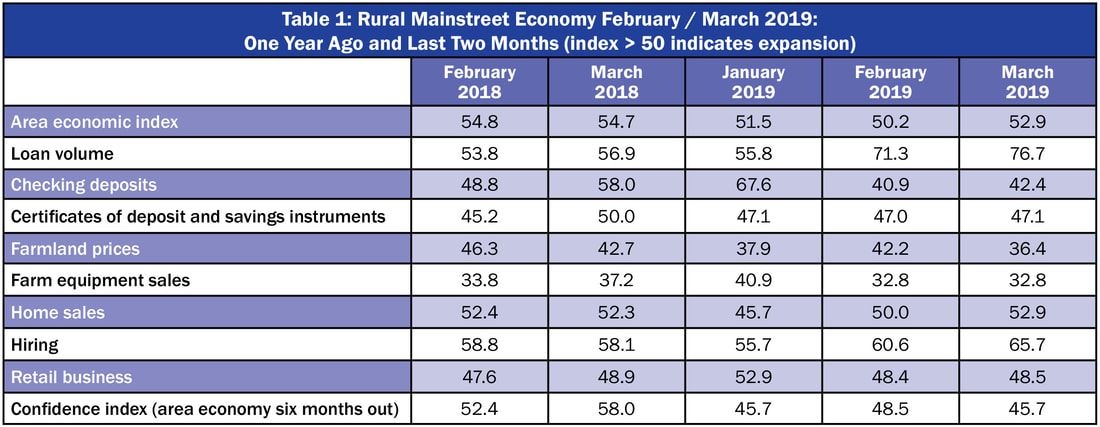- Overall index remains above growth neutral for the 11th time in past 12 months.
- Bank CEOs project a 6.1 percent decline in farm equipment sales over the next year compared to a 6.9 percent reduction last February.
- Weak farm income has pushed almost two-thirds of banks to increase collateral requirements on farm loans.
- Almost one-third of banks have increased the farm loan rejection rate due to anemic farm income.
Overall: The overall index sank to 50.2 from January’s 51.5. This was the 11th time in the past 12 months the index has remained above growth neutral. The index ranges between 0 and 100 with 50.0 representing growth neutral.
“Our surveys over the last several months indicate the Rural Mainstreet economy is expanding outside of agriculture. However, the negative impacts of tariffs and low agriculture commodity prices continue to weaken the farm sector,” said Ernie Goss, PhD, Jack A. MacAllister Chair in Regional Economics at Creighton University’s Heider College of Business.
Farming and Ranching: The farmland and ranchland-price index for January increased to 42.2 from 37.9 in January. This is the 63rd straight month the index has fallen below growth neutral 50.0.
The January farm equipment-sales index slumped to 32.8 from January’s 40.9. This marks the 66th consecutive month that the reading has remained below growth neutral 50.0.
Bankers were asked to estimate the change in agriculture equipment sales in their area for the next year. On average, bankers expect another 6.1 percent decline in farm equipment sales over the next year. This is an improvement from last year at this time when a 6.9 percent decline was expected.
Banking: Borrowing by farmers for February was strong as the borrowing index soared to 71.3 from January’s 55.8. The checking-deposit index plummeted to 40.9 from January’s 67.6, while the index for certificates of deposit and other savings instruments slipped to 47.0 from 47.1 in January.
James Brown, CEO of Hardin County Savings Bank in Eldora, Iowa, reported, “(Weak farm income has produced) more restructuring with ag loans to shore up working capital and reduce term payments if possible while commodity prices remain low.”
This month bankers were asked to identify their bank’s response to weak farm income. Almost two-thirds, or 62.6 percent, indicated collateral requirements have been raised on farm loans. This compares to 45.2 percent for February 2018.
Almost one-third, or 30.3 percent of bankers, reported that a higher percentage of farm loan applications had been rejected. This compares to 21.4 percent of banks in February 2018 that reported they had rejected a higher percentage of farm loans.
Hiring: The employment gauge climbed to a healthy; 60.6 from January’s 55.7. Despite weak farm commodity prices and farm income, Rural Mainstreet businesses continue to hire at an improved rate. Over the past 12 months, the Rural Mainstreet economy added jobs at a 1.1 percent pace compared to a higher 1.6 percent for urban areas of the same 10 states.
Confidence: The confidence index, which reflects bank CEO expectations for the economy six months out, climbed to a still anemic 48.5 from January’s 45.7, indicating a pessimistic economic outlook among bankers.
“Tariffs, trade tensions, weak agriculture commodity prices and anemic farm income negatively influenced the economic outlook of bank CEOs,” said Goss.
Home and Retail Sales: The home-sales index increased to 50.0 from 45.7 in January. Retail sales sank to 48.5 from January’s 52.9.
This survey represents an early snapshot of the economy of rural agriculturally and energy-dependent portions of the nation. The Rural Mainstreet Index (RMI) is a unique index covering 10 regional states, focusing on approximately 200 rural communities with an average population of 1,300. It gives the most current real-time analysis of the rural economy. Goss and Bill McQuillan, former chairman of the Independent Community Banks of America, created the monthly economic survey in 2005. Below are the state reports:
| Colorado: Colorado’s Rural Mainstreet Index for February climbed to 52.3 from 51.6 in January. The farmland and ranchland-price index rose to 42.7 from January’s 38.0. Colorado’s hiring index for February climbed to 63.9 from January’s 56.2. Over the past 12 months, Colorado’s Rural Mainstreet economy added jobs at a 3.3 percent pace, while urban areas in the state increased jobs by 2.7 percent. Illinois: The February RMI for Illinois fell to 50.5 from 52.2 in January. The farmland-price index climbed to 42.3 from January’s 38.3. The state’s new-hiring index increased to 59.1 from last month’s 58.5. Over the past 12 months, Illinois’ Rural Mainstreet economy added jobs at a 1.3 percent pace, while urban areas in the state increased jobs by 1.2 percent. Iowa: The February RMI for Iowa sank to 49.3 from January’s 54.2. Iowa’s farmland-price index increased to 41.9 from January’s 37.8. Iowa’s new-hiring index for February expanded to 55.9 from 53.4 in January. Over the past 12 months, Iowa’s Rural Mainstreet economy added jobs at a 0.0 percent pace, while urban areas in the state increased jobs by 1.8 percent. Kansas: The Kansas RMI for February declined to 50.9 from January’s 51.9. The state’s farmland-price index increased to 42.4 from 38.2 in January. The new-hiring index for Kansas advanced to 60.1 from 57.3 in January. Over the past 12 months, Kansas’s Rural Mainstreet economy added jobs at a 1.3 percent pace, while urban areas in the state increased jobs by 1.5 percent. Minnesota: The February RMI for Minnesota dipped to 47.4 from January’s 50.1. Minnesota’s farmland-price index improved to a still weak 41.4 from 37.5 in January. The new-hiring index for February increased to 50.7 from January’s 50.2. Over the past 12 months, Minnesota’s Rural Mainstreet economy lost jobs at a pace of minus 0.9 percent, while urban areas in the state increased jobs by 1.5 percent. | Missouri: The February RMI for Missouri dipped to 53.4 from 53.5 in January. The farmland-price index for the state increased to 43.0 from January’s 38.9. Missouri’s new-hiring index for February slipped to 54.7 from January’s 55.8. Over the past 12 months, Missouri’s Rural Mainstreet economy added jobs at a 1.7 percent pace, while urban areas in the state increased jobs by 1.3 percent. Nebraska: The Nebraska RMI for February sank to 49.4 from January’s 50.9. The state’s farmland-price index slumped to 42.0 from last month’s 47.8. Nebraska’s new-hiring index climbed to 56.2 from January’s 53.4. Over the past 12 months, Nebraska’s Rural Mainstreet economy added jobs at a 0.8 percent pace, while urban areas in the state increased jobs by 1.5 percent. North Dakota: The North Dakota RMI for February rose to 52.7 from January’s 51.8. The state’s farmland-price index increased to 42.8 from 38.2 in January. The state’s new-hiring index expanded to 65.0 from 57.0 in January. Over the past 12 months, North Dakota’s Rural Mainstreet economy added jobs at a 2.9 percent pace, while urban areas in the state increased jobs by 1.4 percent. South Dakota: The February RMI for South Dakota remained above growth neutral, but fell to 51.3 from January’s 55.0. The state’s farmland-price index increased to 42.5 from January’s 34.5. South Dakota’s new-hiring index expanded to 61.3 from 58.2 in January. Over the past 12 months, South Dakota’s Rural Mainstreet economy added jobs at a 1.7 percent pace, while urban areas in the state increased jobs by 2.5 percent. Wyoming: The February RMI for Wyoming declined to 52.5 from January’s 53.4. The February farmland and ranchland-price index increased to 43.3 from 38.8 in January. Wyoming’s new-hiring index climbed to 69.2 from 63.5 in January. Over the past 12 months, Wyoming’s Rural Mainstreet economy added jobs at a 3.8 percent pace, while urban areas in the state increased jobs by 0.9 percent. |



 RSS Feed
RSS Feed